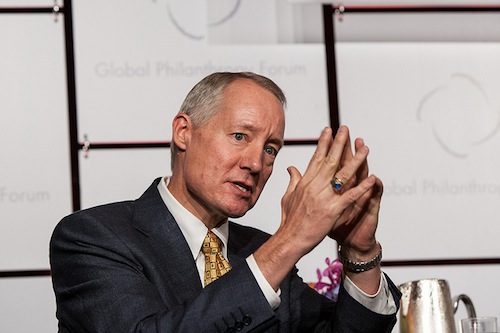At GPF, Finding a Way (or Making One) for Foundations to Impact Invest
Ron Cordes spent more than 25 years in the traditional investing world. He co-founded and in 2006 sold AssetMark Investment Services to Genworth Financial where he serves of co-chairman of the $24 billion asset management firm. However, it wasn’t until Cordes started a philanthropic family foundation that he faced his largest investing challenge: determining how to put a chunk of his foundation’s endowment into impact investments. “That was the most difficult process of my investment career. I had no idea where to put the money,” Cordes said while speaking on a panel about the role of private capital at last week’s Global Philanthropy Forum in Washington D.C.
Family foundations like The Cordes Foundation are often considered the low-hanging fruit of impact investing: their mission-driven philosophies combined with their perceived nimbleness make them ideal candidates to become first movers and concept-provers. However, Cordes and his co-panelists illustrated the barriers that exist even for them when trying to put their money towards companies that create positive impacts.
Leisel Pritzker Simmons, vice president and director of Program Development for the IDP Foundation (and part of the Pritzker family of the Hyatt Hotels fortune) spoke about her own challenges in attempting to enter the impact investing arena. The IDP Foundation made a grant to fund low-cost private schools in Ghana. The success of the grant then catalyzed subsequent microfinance investment in the schools. But when Pritzker Simmons wanted to invest some of her assets into the schools as well, she was told by her financial advisor that her foundation was not set up to do so, and that investing this way would not be a wise move anyway. What was a successful grant turned into an ongoing and frustrating attempt to expand the impact using investment dollars.
Financial advisors, according to Cordes, are key to unlocking the capital held by foundation endowments and individuals. “To catalyze investors, you need to catalyze financial advisors,” he said during the panel discussion. However, the lack of successful track record of successful impact investment deals listed by the Global Impact Investing Network as the number one barrier to impact investing can make financial advisors as wary about the sector as big institutional investors. A lack of knowledge and resources compounds this issue.
An infrastructure needs to be developed that gives foundations and individuals the ability and knowledge to place their dollars into impact companies. During his own experience trying to place a portion of The Cordes Foundation’s endowment into impact investing, Cordes said he brought in a team of MBA students to seek out the best fund managers in the field, and came up empty. Ultimately he did manage to put 20 percent of the Cordes Foundation’s endowment in impact investments, and was surprised to find that in their first year (at the height of the financial crisis) these investments outperformed the more traditionally invested portion of the endowment.

To address issues faced by would-be impact investors, Cordes (Pictured left) partnered with The Calvert Foundation to create ImpactAssets, a non-profit financial fund. ImpactAssets structures impact investment vehicles appropriate for philanthropists and individuals, and creates resources such as the ImpactAssets 50, a list of experienced fund managers focused on impact. Impact investing also seems to be appearing on the radar of financial advisors, with articles appearing the past 18 months in sources such as The Dow Jones Financial Advisor blog and Financial Advisor Green.
So, with this growing infrastructure, are foundations and wealthy individuals jumping at the chance to transfer their endowments and investment dollars into impact investments? At this stage, foundations and high net worth individuals seem cautious but intrigued by impact investing. According to a 2010 study by Hope Consulting, a strategy consulting firm focused on the social sector, 48 percent of wealthy investors were interested in and wanted to learn more about impact investing. Although some Global Philanthropy Forum attendees expressed their hesitation at the heralding of impact investing as “a silver bullet” that could solve all problems, I met many foundation representatives in the crowd interested in the prospect, as well as advisors who were attending the forum on behalf of clients interested in learning more about impact investing.
Annie Chen, a Hong Kong based impact investor and co-panelist with Cordes and Pritzker Simmons, gave perhaps the most useful input of the day to forum attendees contemplating impact investing. “Don’t wait for the perfect investment,” she advised. “There is no perfect investment – impact or not. But there are investments out there that can create change.”
- Categories
- Uncategorized
